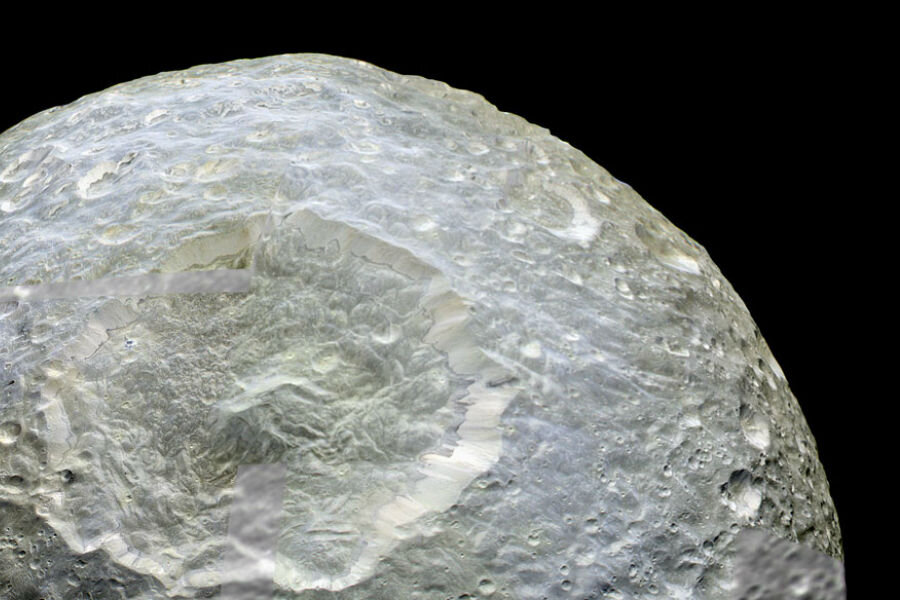Does Saturn's moon Mimas have an ocean under its icy surface?
Saturn's moon Mimas – the munchkin among the ringed planet's major moons – is finally getting some love.
A new analysis of images taken by NASA's Cassini orbiter, currently touring Saturn and its moons, has uncovered evidence that suggests the moon may have a global, under-ice sea, much like its larger cousin, Enceladus.
The team conducting the analysis notes that the measurements they made could point to a frozen-solid moon with a rocky core shaped like a rugby ball. But if the under-ice sea explanation holds up, Mimas could represent one more potential habitat for simple forms of organic life.
Either way, Mimas is turning out to be far more intriguing than many initially thought it would be, explains Radwan Tajeddine, an astronomer and research associate at Cornell University in Ithaca, N.Y.
“This moon is more complex than we imagined,” says Dr. Tajeddine, the lead author of the analysis, which will be published Friday in the journal Science.
Among Saturn's moons, Mimas has been something of a low-key cousin compared with its larger, more flamboyant relatives Titan and Enceladus.
Titan, Saturn's largest moon, has a thick atmosphere and chemistry rich in organic compounds – in many ways resembling Earth before life emerged. It's surface hosts hydrocarbon lakes, and researchers have uncovered evidence for a sea with salinity comparable to the Dead Sea beneath Titan's surface.
Enceladus is an icy world with evidence of an ocean beneath its ice crust. And it is geologically active, with plumes of water venting from a series of cracks in the crust near the moon's south pole.
Both moons are of keen interest to astrobiologists as potential habitats for simple forms of organic life, for which liquid water is seen as a necessity.
For its part, Mimas has been of interest for its slightly out-of-round shape and for its role in clearing a pronounced gap between Saturn's two widest rings – a 4,800-mile-wide clearing known as the Cassini Gap. Mimas' most recognizable feature is its 88-mile wide Herschel Crater, a ding up to six miles deep in a moon that is only about 246 miles across. Hold the proportions constant and apply them to Earth, and the crater would span about 2,500 miles – swallowing nearly all of the continental United States, and large patches of Canada and Mexico. The crater gives the moon the appearance of the Death Star.
Mimas' heavily cratered surface suggests to many researchers that it was relatively boring. The number of craters suggested the surface was old; it hadn't undergone the kind of current, or even geologically recent, repaving seen on Enceladus.
Still, a frozen moon could represent a time capsule hiding “fossil” structures beneath the surface that would speak to its origins. So Dr. Tajeddine and colleagues from universities in France and Belgium made the first attempt at trying to determine what the moon's interior is like.
The results could help shed light on a mystery: Why does Mimas, mostly water ice with a smattering of rock, appear to be frozen solid at a bracing -334 degrees Fahrenheit while Enceladus, also an ice world, hosts an interior sea?
This sea is made possible by Enceladus's elliptical orbit around Saturn and Saturn's enormous gravitational tug. These set up tidal forces within the moon that generate frictional heat, keep Enceladus' internal ocean from freezing.
Yet Mimas, which orbits some 115,280 miles from Saturn, is much closer to the planet than Enceladus, which orbits 147,500 miles away. And Mimas' orbit traces a more eccentric ellipse than does Enceladus' orbit. Mimas should experience more tidal heating, which should lead to liquid water somewhere inside the moon. Yet Mimas' heavily cratered surface and lack of geyser-like activity suggests the moon is frozen solid and has been for a long time.
Tajeddine and colleagues used 40 high-resolution images from Cassini's narrow-angle camera to pick out and build a 3D map of 260 reference points on the moon's pock-marked surface. They used a sophisticated mathematical approach to track changes in the position of these points as Mimas orbits. The changes show up as a sideways wobble across the field of view.
If the moon was solid, with a core matching the shape of the outer shell, the size of the wobble should have been about 1.9 miles from one side to the other. Instead, it was twice that, Tajeddine says.
Only two of the models represented plausible explanations. But each explanation still had problems. For instance, if you have a rugby-ball shaped core, the final shape of the moon should resemble that. Mimas does not.
What are the plausible ways you could have a rugby-shaped core and it up with a nearly spherical moon? One very plausible way is with a liquid ocean. The rest of your moon is disconnected from the core by this body of water.
The challenge with the global ocean is Mimas got no evidence on the surface indicating the presence of water underneath, or the activity of water moving up through the crust.
The moon shows none of the surface features that appear on Enceladus, or even Jupiter's moon Europa, that signal past or current reshaping of the surface.
That doesn't need to be a show-stopper for a global-ocean on Mimas, Tajeddine explains, noting that Jupiter's icy moons Ganymede and Callisto show little or no signs of resurfacing but are now thought to host under-ice oceans.
The team offers additional ways to settle the questions surrounding Mimas' interior – one of which would require a close flyby or two of Mimas to measure any unexpected features in its gravitational field. Another would involve detailed temperatures measurements of the surface to hunt for locations that show unexpected warmth.






